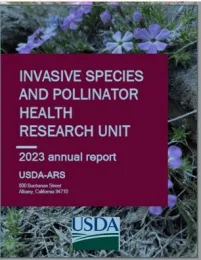
The full report is attached at the bottom of this post, but here are a few of the topics that grabbed my attention and might be of interest to the readers of this blog:
- Invasiveness of yellow flag iris (Iris pseudacorus L.) with climate change
- Biological control of yellow starthistle (Centaurea solstitialis)
- Biological control of arundo (Arundo donax) in the Central Valley
- Biological control of Cape-ivy (Delairea odorata) along the California coast
- Biological control of invasive annual grasses
- Mechanisms of plant-microbe interactions in cheatgrass invasion
- Using molecular tools to characterize bioherbicide bacteria
- Biological control of gorse (Ulex europaeus)
- Future biological control of crystalline ice plant in California
- Classical biological control of Russian thistle (Salsola spp.)
- Alligator weed (Alternanthera philoxeroides): ecology and spread of a recent northern California invasion
- Classical biological control of alligator weed (Alternanthera philoxeroides)
- Common reed (Phragmites australis): genetic study clarifies identity of populations in California's San Francisco Bay-Delta Estuary
- Classical biological control of Scotch broom (Cytisus scoparius)
- Future biological control of stinkwort (Dittrichia graveolens) in California
- There are also brief updates on projects on South American spongeplant (Limnobium laevigatum), pampas grass (Cortaderia selloana), common crupina (Crupina vulgaris), rush skeletonweed (Chondrilla juncea) and Uruguayan primrose-willow (Ludwigia hexapetala).
Take a look at some of the great weed-related work being done by our USDA-ARS weed ecology/management/biocontrol colleagues in Albany and Davis, California.

